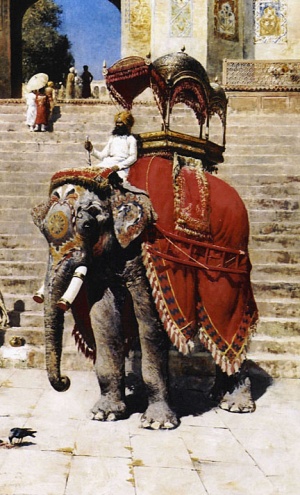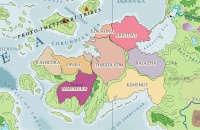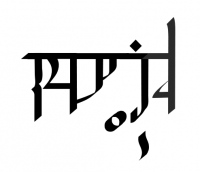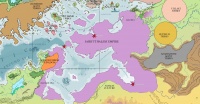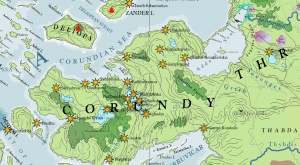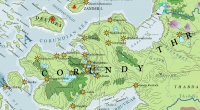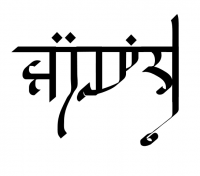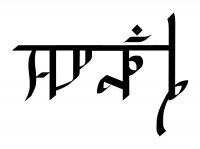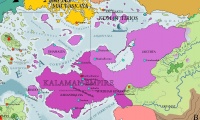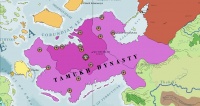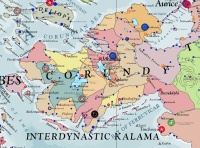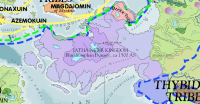List of Rulers and Dynasties of Kalama
The records of Kalama provide us a sequence of eleven kingdoms, each composed of numerous dynasties and reaching back unthinkably into the past. Scholars generally accept the historicity of the king lists from the sixth millennium before Salmakhamer towards the present. Rulers before this time are considered legendary or semi-legendary. Non-native and some native scholars regard the historicity of the Sanjasthanite Kingdoms with much skepticism believing it to be completely or largely fabricated. During this period, it is important to keep in mind that the recorded dynasty may not have held universal rule over all of Kshandiguh (the Corundian Peninsula).
During the periods when the Kshandiguh was united, the ruler was called the Zhara Jurpa or the regenerative king of the land whose well-being and righteousness ensured the prosperity of the great kingdom.
List of Dynasties and Rulers of Kalama
Mythical Sanjasthanite Kingdoms
date from Great Flood of Aturyanda 11,770 AS to 6,950 AS The term 'Sanjasthanite' comprises all kingdoms and rulers dated before the period of chaos cults in the seventh millennium before Salmakhamer. They are ascribed to the period immediately after the Flood of Aturyanda and according to the Aturyandakumi and other legends, the great Aturyanda was the first ruler over Kshandiguha after the flood.
Arredat Kingdom
Balazha Kingdom
One of the Sanjasthanite Kingdoms, Balazha is mentioned a few times in the Aturyandakumi. Its ruler was the grandson of another flood survivor hero. Scholars believe that they spoke a language related to proto-Jathya-Dhumi, based upon proper names that are recorded in ancient legends.
Imsephura Kingdom
The memory of the indigenous elves of mythical Corundy is recorded in very ancient legends of Kalama. The elves lived in the densely forested area of central west Corundy. Over the subsequent millennia, they ceased to exist. Whether the native elves emigrated, died through warfare or disease, or ceased to reproduce is not fully clear. Scholars believe that elves no longer existed in Corundy at some point before the time of Chaos Rule before ca 7,000 AS.
(10,700 to 8,400 AS) The Kemenut Kingdom held dominion in the southeastern Corundian Peninsula, enduring to the middle of the ninth millennium before Salmakhamer. It was contemporary with the Thaulya Kingdom and the woodland elves of western Corundy (Imsephura).
Lokhona Kingdom
Opars
Mythical creatures
Rashedra
Thaulya Kingdom
- Palace:
11,770 AS to 10,454 (~1316 years)
- Aturyandan Dynasty, 11,770 AS to 11,512 AS, (~258 years)
Aturyanda (previously ruler of Kathyasundi until exiled)
- Aturyanda
- Thaulyokha "Dedicated to the Sun Goddess, Thaulya"
Sahaupaisha Kingdom
- Palace:
10,454 AS to 9,482 AS, (~972 years)
- Farmer-Kings, 10,325 AS to 10,000 AS
- Invasion of Dragons and Tritons, 9,700 AS to 8,350 AS
Prikanuccha Kingdom
- Palace:
9,482 AS to 8,389 AS, (~1,093 years)
- ~8700 AS Flood of Karuthaya
Time of Karuthaya, ca 8700, legendary priest-king of Vimalia
Gurshur Kingdom
- Palace:
8,389 AS to 7,716 AS, (~673 AS)
- Dynasty
- Dynasty
- Vindalian Dynasty, 8035 to 7821 AS (~214 years)
Bhindala ("Vindalos" in Ithatian) is founder, his name becomes origin of ‘Vindalia’ lands of Kshandiguh and Jakubya
- Bhindala
- Chadragushma Dynasty, 7821 to 7716 AS (~105 years)
Bhonippa Kingdom
- Palace:
7,716 AS to 6,992 AS, (~724 years)
- Sratna Dynasty, 7716 AS to 7619 AS, (~97 years)
- Lamputthal Dynasty, 7619 AS to 7478 AS, (~141 years)
- Auksha Ithwa Dynasty (Auksha Ithwa), 7478 AS to 7453 AS (~25 years)
- Dhakhur Auksha Ithwa, only ruler of this dynasty, assumes throne at expense of decadent Lamputthal Dynasty
rules, but cursed without heir and must surrender kingship to kinsman, Tanchala
- Ithwa-Tanchalese Dynasty, 7,453 AS to 7,346 AS (~107 years)
- Tanchala I, 7,453 AS to 7,445 AS, (~8)
- Kayattha, 7,445 AS to 7,431 AS, (~14)
- Tanchala II, 7,431 AS to 7,410 AS, (~21)
- Ipshaz I, 7,410 AS to 7,401 AS, (~9)
- Ipshaz II, 7,401 AS to 7,364 AS, (~37)
- Ipshaz III, 7,364 AS to 7,351 AS, (~13) (under Regency)
- Bakhurya, Usurper, 7,351 AS to 7,349 AS (~2)
- Ipshaz III, Restored Reign, 7,349 AS to 7,346 AS (~3)
- Jairutthalese Dynasty, 7,346 AS to 7,284 AS (~62 years)
- Jairutthala, 7,346 AS to 7,319 AS (~27 years); founder of Tanshakilu and Jairutthaloksha
Samptarah ahwa Kamaddhu: Court poet to Jairutthala from Zhahambira
Founding of Tanshakilu, 7,338 AS
- Baihir, 7,319 AS to 7,311, (~8 years)
- Ankhu-Saidhya, 7,311 AS, (<1 year)
- Ankhu-Baihir, 7,311 AS to 7,292 AS, (~19 years)
- Kwatta, 7,292 AS to 7,285 AS(~7 years)
- Ishuthulya, 7,285 AS to 7,284 AS (~1 year) (uncle to Kwatta, younger brother to Ankhu-Baihir), marries his daughter to Sharakshaya and abdicates.
- Sharakshaya Founding Dynasty, 7,284 AS to 7,237, (~47 years)
- Sharakshaya, 7,284 AS to 7,260 AS , (~24 years)
- Aguman, 7,260 AS to 7,244 AS, (~16 years)
- establishment of Kathyabrumya, a dependent municipality 7253 AS
- Aguman II, 7,244 AS to 7,237 AS, (~7 years)
During Sharakshaya Dynasty, founding of colonies throughout eastern Pallathantic, including re-colonization of Hwalaka, eastern Shadevan Delta, Isiagos Island.
- Baukryandi Dynasty, 7,237 AS to 7,215 AS (~22 years)
- Baukryandi, 7,237 AS to 7,215 AS
- Sharakshaya Restoration Dynasty, 7,215 AS to 7,184 AS (~31 years)
- Hesukhyanda, 7,215 AS to 7,206 AS (~9 years)
- Sharakshaya II, 7,206 AS to 7,188 AS (~18 years)
- Sharakshaya III, 7,188 AS to 7,184 (~4 years)
- Khulkha Dynasty, 7,184 AS to 7,095 AS (~89 years)
- Dacchambya Dynasty, 7,095 AS to 7,038 AS (~57 years)
- Dacchambyantese War, 7,038 AS to 6,992 AS (~46 years)
Fought among noble factions purporting to restore the Dacchambya Dynasty, all subverted by priests of Chaos Gods. Ends when all pretenders to the throne are slain or renounce the throne. Tanshakilu becomes the capital to prevent subversion to chaos, but fails.
Chaos Rule
During this period, the mythical Royal Tusk of Shandhur is said to have been lost or taken back by the gods.
(6,992 AS to 6,100 AS) Chaos Priests rule the empire as a body and chaos high priests rule the various great cities of the empire with much autonomy. Chief Priest of Chaos, High Priest

- Rule of the Kaiwakkha Shaluspahi, 6,992 AS to 6,906 AS (~86 years)
College of the Priests of the Gods (Chaos Gods), based in predecessor to Aturoksha (Addinoro)
- Dacchambya Restoration, 6,906 AS to 6,816 AS (~90 years)
Dacchambya heir becomes ruler, but worships chaos.
- Ruler, 6,906 AS to x, (~13 years)
- Ruler, , (~37 years)
- Ruler, , (~23 years)
- Ruler, , (~11 years)
- Ruler, 6,822 to 6,816 AS, (~6 years)
- Restoration of Rule of Kaiwakkha Shaluspahi, 6,816 AS to 6,147 AS
ca 6,400 AS, creation of the Flampesha (Tassan Name) skyness
- Missions of the Sungotine Prophets, 6,270 AS to 6,120 AS
- Ankhura-Sin
- Senior chaos priest of the Kaiwakkha Shaluspahi, lived 6,249 AS to 6,152 AS (~97 years)
ca. 6,150 AS: Internecine strife among the Kaiwakkha Shaluspahi, college dismantled
Towards the end of the Chaos Period (Ca 6,100 AS), legend recounts that the first Jathya-Dhumi People immigrated into Kalama.
Kalaman City States
Most non-native modern scholars consider accounts before this time to be mythical inventions. 6,100 AS to 4,400 AS Kshandiguh (Kalama Peninsula), Jakubya, Bakyahumya (Thyria), Kaspatya [Ebinoese Headlands], Dalya [Deliops], Saumakya [Thykomos], [Brandolphi],
City-States of Kshandiguh and Jakubya
These are the principal, independently ruled city-states of Kalama around 5,000 AS. The modern site is given in parentheses.
- Jukhaulya: Under rule of the Bara Giants
- Aturoksha (Addinoro), Hanumbasha Dynasty (4,423 AS to 4,320 AS, (~103 years))
- Challanushra, Shrumantwa Dynasty
- Kathyabrumya (Cetibrymio), Pradhuma Dynasty
- Jaumahu (Laxiapoion)
- Zhahambira (Zeddi), Zashtira Dynasty
- Sakhubryar (none)
- Maghadhayuta (none)
- Dhaihar Hesukhoksha (Azabria)
- Bhimaloksha (Vimaluna), Thirs'uttha Dynasty
- Ghahapand (Omflune)
- Gampha Shakhuphshi (Babirrhoksha, Estyo Rhe); King Ghubjhazya + Queen Thirchunya; King of Gampha Shakhuphshi during the early sixth millennium AS.
- Gamphapand (Flampesha), Heluzagda Dynasty
- Thugabya (Thugdabis), Vimalayanda Dynasty
- Ganam Kurakula (Brandolphi)
- Austar (Ontigaire)
- Bispalhu (Tiomaire)
- Tawdhu (Desthorion)
- Tanshakilu (Mirrhaimo), Umanktiri Dynasty
- Limshandah (none)
- Aghudra (Agdaire)
-pand: tower, lighthouse, watch
- Other City States
- Thaulyoksha (Zamaclë), G’am Ophusír, Kirayshath (Ebinóë), Gumara (Kumeikë), Aluzabi, Bogor Bisht, Thrimsol
Invasion of Adamantine Giants, ca 4,800 AS to 4,400 AS
- High Culture of Kalama, 4,400 AS to 2,450 AS, Hegemony over Malesggites
- First contacts with the Neptultchi
- Hanumbasha Dynasty, 4,423 AS to 4,320 AS, (~103 years)
defeat of Adamantine giants, re-unification of Kalama
Contemporary Civilizations and Peoples of Asdar
- ca. 4,500 AS
- Omre—Juheb-tah Kingdom, 4,750 AS to 4,330 AS
- Thybdis River Civilization
- Shalkhumi City-States
- Thadnochori Tribes of Ancient Erserce
- Thetzisari Tribes
- Common Giants of the Ephysgæes
- Common Giants of southern Pytharnia
- Common Giants of the Adamantine Mountains
Gahashpujani Kingdom
- Palace: Kathyabrumya (Cetibrymio))
This is the beginning of the High Culture of Kalama. Contemporary with the Kingdom of Tirios
- 4,317 AS to 3,733 AS, 584 yrs
- Capital established in Kathyabrumya (Cetibrymio) by the Hanumbasha Dynasty of Aturoksha
- ~4,300 to 4,000 AS, immigration of Esabdalite People, enlisted as mercenaries against Adamantine Giants
- Tramasthajya Dynasty 4,320 AS to 4,247 AS (~73 years)
descended from Kupthaukhas, demi-mortal ability to shapechange
- Gahashpujani Dynasty 4,247 AS to 4,151 AS (~96 years)
Kalaman early Bronze Age begins (4200 AS to 3000 AS)
- Challagahrra Dynasty 4,151 AS to 4,094 AS (~56 years)
[“Challa” Sunmoon + “Gahrra” follower, observer]
- Zhaptuh Dynasty, 4094 AS to 3968 AS, (~156 years);
- Mehrikuna Dynasty, 3968 AS to 3915 AS, (~23 years); propped-up by Esabdalite mercenaries; collapses due to internal unrest combined with invasions on frontier
- Drasa Dynasty, 3915 AS to 3733 AS (~182 years); Esabdalite Dynasty;
- ca 3750 AS Centaur Invasion; collapse of Gahashpujani Kingdom
Pandhauzhi Kingdom
- Palace: Gampha Shakhuphshi (Babirrhoksha)
High Culture of Kalama, Contemporary with the Kingdom of Tirios 3,733 AS to 3,255 AS, 478 yrs Ambharaghasha rulers move capital to Gampha Shakhuphshi (Babirrhoksha) in west Kshandiguh (west Corundy)
- Ambharaghasha Dynasty, 3733 AS to 3552 AS, 181 yrs
- invention of water wheel in the Valley of Vimal
- Luhimnauskhu Dynasty, 3551 AS to 3455 AS, 97 yrs
- Shayarin Zhampha speculated time
- Jhabha-Khwattomugh Dynasty, 3454 AS to 3428 AS, 27 yrs
3 rulers
- Swakthuni Dynasty, 3427 AS to 3369 AS, 59 yrs
- Thagghabhiru Dynasty, 3368 AS to 3286 AS, 83 yrs
- internecine strife, 3285 AS to 3255 AS, 31 years
collapse of Pandhauzhi Kingdom
Neibhu-Yona Kingdom
- Palace: Vimaluna --> Jhukhaulya (Johaulia)
- 3255 to 3042 AS, 213 yrs; Contemporary with the Kingdom of Tirios
Palace originally in Vimaluna. Trade and cultural hegemony of the Malesggites (Shadevan Delta) continues.
- Samankha Dynasty, 3255 AS to 3138 AS, ~117 yrs
- first dynast, 3255 AS to 3224 AS
- second dynast, 3224 AS to 3207 AS; besieges Bara giants in great fortresses northeast of Lake Amalkumir, defeats giants, renames place 'Jukhaulya' and establishes his capital palace in its place.
- Palace and administrative buildings established in Jhukhaulya (Johaulia) due to the favorable defensible location of the town
- Jhelumjhahuth Dynasty, 3137 AS to 3042 AS, ~95 yrs
rebellions and dissensions among the tributary kingdoms and princes help bring about the end of the dynasty.
Surizhah Kingdom
- Palace: Aturoksha (Addinoro)
- Last Kingdom of the High Culture of Kalama, Contemporary with the Kingdom of Tirios
3042 AS to 2323 AS, ~719 yrs capital moved to Aturoksha, (Addinoro)
Decline of Kalama, 2,450 AS to 1,100 AS
- Zombie Plagues, 2,400 AS to 2,100 AS
Neptultchi undead
- During this time, Sun-Cult established in Thaulyoksha (Zamaclë) 2666 AS, according to legend and stone monuments.
- Sursaha Dynasty 3042 AS to 2780 AS, 262 yrs
- Kalaman scholars revive interest in ancient sources that concern the worship of the Lords of Light also known as the Lords of Creation.
- Wakhumand Dynasty, 2780 AS to 2696 AS, 84 yrs
- Kalaman scholars continue interest in ancient sources that concern the worship of the Lords of Light also known as the Lords of Creation.
- Pajatta Dynasty, 2696 AS to 2519 AS, 177 yrs
- Gundhramon Dynasty, 2519 AS to 2330 AS, 189 yrs
- ca 2370 AS
- Zamaclë: Cataclysm of the Screeching Maidens. Associated disasters include earthquakes in Vimalia and Ithatia, and flooding of Lake Vimala.
- ca 2400 AS
- Early Migration of Pallathantic Tribes in eastern Pallathantic Sea
- Uhappha Dynasty, 2330 AS to 2323 AS, 7 yrs
King Thuptala of the Uhappha Clan. Only rules seven years and is slain with much of his court in a disastrous earthquake that strikes Aturoksha.
Tamukh Kingdom
Considered after the High Culture of Kalama, part of the slow decline of Kalaman civilization. Transition between late bronze age and early iron age, ca 2100 AS.
- 2323 AS to 1884 AS, 439 yrs; Kingdom named after first Dynasty, 'Tamukh,' who rebuilt the Palace in Aturoksha
- ca 1900 AS defeat of Neptultchi Pirates in Sea of Forgetfulness
- War of the Dragonfolk (Kalaman Epic), epic composition, dated to late Sinaskha-Pramu Dynasty, describes conflict between Vimalians and Dragon Folk (Neptultchi) in the Tanjakhri Siyalit Dynasty
- Manshuyanda the Spell-strong of Aturoksha, powerful wizard who established a school of wizardry in the Tamukh Dynasty, 2323 As to 2210 AS
- Tamukh Dynasty, 2323 AS to 2210 AS, 113 yrs
- Kamalsuddhu Dynasty, 2210 AS to 2132 AS, 78 yrs
- Dhusakwebhit Dynasty, 2132 AS to 2088 AS, 44 yrs
- Tanjakhri Siyalit Dynasty, 2088 AS to 1935 AS, 153 yrs
Dynasty that saw the lasting defeat of the Neptultchi Pirates in the Sea of Forgetfulness
- ca 2000 AS; continued attacks of the Pallathantic Tribes 'Sea Peoples' against the northern coasts; sea trade affected;
Contribute to collapse of Tamukh Kingdom
- Sinaskha-Pramu Dynasty, 1935 AS to 1884 AS, 51 yrs
Interregnal Period
- 1884 to 1729 AS, 155 yrs
No central Great King of Kalama holds sway. High Nobles rule local fiefs and cities. Aturoksha governed by the high priest of Atur.
- Local Capitals and City-States of the Interregnal Period
- Aghudra (Agdaire)
- Aturoksha (Addinoro)
- Jhukhaulya (Johaulia}
- Kathya-Brumya (Cetibrymio)
- Bhimaloksha (Vimaluna)
- Ghahapand (Omflune)
- Gampha Shakhuphshi (Babirrhoksha, Estyo Rhe);
- Gamphapand (Flampesha)
- Thugabya (Thugdabis)
- Tanshakilu (Mirrhaimo)
- Challanushra
Jatha-Nebir Kingdom
- Palace: Jhukhaulya (Johaulia)
- Last Kingdom
- 1729 AS to 1117 AS, (~612 years)
- Non-indigenous to Kshandiguha, rulers come from Jakubya (Lucacia)
- during this time it is thought the Kalaman Elephant became extinct.
- The palace was moved back to Jhukhaulya.
- Therya-Prakrip Dynasty, 1729 AS to 1632 AS, (~97 years)
- Ummattha Dynasty, 1631 to 1578 AS, ~54 yrs
- 1597: Aturoksha becomes subject to Ummattha Dynasty
- Kalyal Zhirpha II; 1579 to 1577 AS; last ruler of Ummattha Dynasty
- Bhirukamphan Dynasty, 1577 AS to 1405 AS, ~173 yrs
Rulers endeavor to consolate the subject chieftains and princes. Establishment of the 'High Kingdom', cities that are directly subject to King, consists of Vimalia and Rhiony.
- Shan Dahar I; 1577 AS to 1562 AS; ~15 yrs
- Shan Dahar II; 1562 AS to 1550 AS; ~12 yrs
- Taruja Chahudra; 1550 AS to 1547 AS; ~3 yrs
contemporary: final collapse of Neptultchi Civilization, ca 1550 AS
- Kwandyanda Dahar; 1547 AS to 1526 AS; ~21 yrs
- Shayuwama Dahar; 1526 AS to 1513 AS; ~13 yrs
- Bahim Dahar; 1513 AS to 1496 AS; ~17 yrs
- Chal Dahar I; 1496 AS to 1453 AS; ~43 yrs
- Chal Dahar II; 1453 AS to 1444 AS; ~9 yrs
- Sumiyanda; 1444 AS to 1425 AS; ~19 yrs
- Khaphra Dahar; 1425 AS to 1406 AS; ~19 yrs
- Shan Dahar III; 1406 AS to 1405 AS; ~1
- Notable Persons
- Djavanchi Tampatya Saphiramjhaña: masterful wizard, b 1609, d 1526, ~83
- Karyigha Thaulyagna Dynasty, 1404 AS to 1354 AS, 51 yrs
- Phalumicchurn Dynasty, 1353 AS to 1267 AS, ~87 yrs
- Addhya-Challa Dynasty, 1266 AS to 1164 AS, ~103 yrs
- Phankala
- Chalmudhra
- Zhalayara Kuswa Dynasty, 1163 AS to 1117 AS, ~47 yrs
last rulers pre-Midrinksi rulers of all Kalama, Jatha-Nebirite rulers retained in high valleys of Vimal
Midrinksi invasions (or settlements, depending upon your historical viewpoint) weaken the Zhalayara Kuswa Dynasty which collapses amid internecine conflicts among potential claimants to the throne of the Great Kingship. None is successful and historians regard this as the end of the Jatha-Nebir Kingdom.
- Ambhiru, 1163 to 1151, ~12 yrs
- Ambhiru II, 1151 to 1117, ~34 yrs
Midrinksi Settlement of Kalama
- 1100 AS to 75 AS
- scions of the Zhalayara Kuswa Dynasty continue to rule local states along with high nobles of pre-Midrinksi stock. Their cultural decline is inevitable and they succumb to the incursions of the Midrinksi nomadic tribes who immigrate with a vast body of horse warriors into Kalama. Kalaman enclaves persist, speaking ancient Kalmaman (Jathya-Dhumi), to this day, largely as a liturgical and scholarly language and the domestic language of a handful of aristocratic families of old Kalaman stock. The Jaithan Language and the Shardanian Language persist as direct developments of the classical Kalaman language.
During this time, vestiges of both Kalaman and Jatha-Nebirite princely dynasties continued local rule in many cities. In other places, Midrinksi chieftains ruled, often retaining locals priests and customs and marrying into the local aristocratic families. The Midrinksi language (later to become 'Midretassene') gains ascendancy as the language of the Midrinksi chieftains and their horse warriors. Midrinksi leaders freely adopt the superior cultural heritage of Kalama (engineering, religion, mathematics, astronomy, medicine, philosophy, literature, Hirgunya Script). Outside of Vimalia, Midrinksi develop their own alphabet, (the Midretassene Alphabet), based upon Hirgunya.
- Note: Vindalia is an ancient name that comprises what is today Corundy and Lucacia (anciently Kshandiguh and Jakubya).
- Note: Vimalia is the name of the Valley of Lake Vimala or Lord Vimal where the the Late Jathiyati Language or early Jaithan Language is spoken
- General Events
- 560’s Thurpashi War: Alliance of Vimalian Princes repel Midrinksi Tribes back into eastern Vimalian Plateau
Aghudra
Aturoksha
- 453 Priest-King of Aturoksha made subject to King of the Midrinksi
- 366 Fall of Aturoksha. King of the Midrinksi establishes royal governor.
Bhimaloksha
(Vimaluna) Ruled by scion of the Jatha-Nebirite Dynasty
- 483, Ruler of Bhimaloksha made subject to King of the Midrinksi
- 371, Fall of Bhimaloksha. King of the Midrinksi establishes royal governor.
Challanushra
Ruled by scion of the Jatha-Nebirite Dynasty
Jhukhaulya
- Autonomous Rule, 1173 to 362 AS
- King rules as ceremonial high priest who is ritually married to the goddess Mahada. His heir is ritually married to the daughter of Mahada.
- According to legend, it is during this time that the god Amirulliam and his companion, Kay'u, visit Jhukhaulya (Johaulia).
- Thupha Apshani Dynasty
- 1173 to 427
- 560’s Thurpashi War: Alliance of Vimalian Princes repel Midrinksi Tribes back into eastern Vimalian Plateau
- Samerkhambu Dynasty
- 427 to 362
- ca 414 AS, ruler of the Samerkhambu Dynasty gives obeisance to the king of the Midrinksi and is permitted to continue rule of the city.
- 362 AS, King of Samerkhambu Dynasty, having revolted, is crushed, fall of Jhukhaulya, the last of the great city-states of Vimalia, end of Samerkhambu Dynasty. King of the Midrinksi sets up a local governor to rule the city. End of Kalaman rule of Johaulia. Native Rule is not re-established until after the Fall of the Yophenthean Empire.
See Also
| This article is a stub. It requires further development by the creator. |
